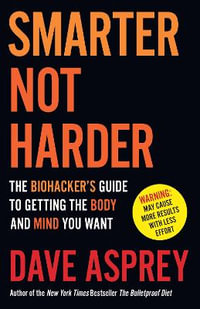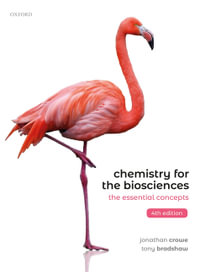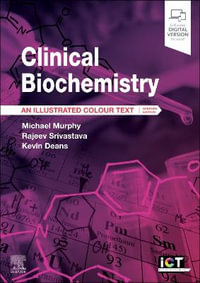
At a Glance
Paperback
584 Pages
584 Pages
Dimensions(cm)
23.39 x 15.6 x 3.0
23.39 x 15.6 x 3.0
Paperback
$187.31
or 4 interest-free payments of $46.83 with
orAims to ship in 7 to 10 business days
Hydrogen bonds are weak attractions, with a binding strength less than one-tenth that of a normal covalent bond. However, hydrogen bonds are of extraordinary importance; without them all wooden structures would
collapse, cement would crumble, oceans would vaporize, and all living things would disintegrate into random dispersions of inert matter.
Hydrogen Bonding in Biological Structures is informative and eminently usable. It is, in a sense, a Rosetta stone that unlocks a wealth of information from the language of crystallography and makes it accessible to all scientists. (From a book review of Kenneth M. Harmon, Science 1992)
Hydrogen Bonding in Biological Structures is informative and eminently usable. It is, in a sense, a Rosetta stone that unlocks a wealth of information from the language of crystallography and makes it accessible to all scientists. (From a book review of Kenneth M. Harmon, Science 1992)
IA Basic Concepts.- 1 The Importance of Hydrogen Bonds.- 1.1 Historical Perspective.- 1.2 The Importance of Hydrogen Bonds in Biological Structure and Function.- 1.3 The Role of the Water Molecules.- 1.4 Significance of Small Molecule Crystal Structural Studies.- 1.5 The Structural Approach.- 2 Definitions and Concepts.- 2.1 Definition of the Hydrogen Bond - Strong and Weak Bonds.- 2.2 Hydrogen-Bond Configurations: Two- and Three-Center Hydrogen Bonds; Bifurcated and Tandem Bonds.- 2.3 Hydrogen Bonds Are Very Different from Covalent Bonds.- 2.4 The van der Waals Radii Cut-Off Criterion Is Not Useful.- 2.5 The Concept of the Hydrogen-Bond Structure.- 2.6 The Importance of ? and ? Cooperativity.- 2.7 Homo-, Anti- and Heterodromic Patterns.- 2.8 Hydrogen Bond Flip-Flop Disorder: Conformational and Configurational.- 2.9 Proton-Deficient Hydrogen Bonds.- 2.10 The Excluded Region.- 2.11 The Hydrophobic Effect.- 3 Experimental Studies of Hydrogen Bonding.- 3.1 Infrared Spectroscopy and Gas Electron Diffraction.- 3.2 X-Ray and Neutron Crystal Structure Analysis.- 3.3 Treatment of Hydrogen Atoms in Neutron Diffraction Studies.- 3.4 Charge Density and Hydrogen-Bond Energies.- 3.5 Neutron Powder Diffraction.- 3.6 Solid State NMR Spectroscopy.- 4 Theoretical Calculations of Hydrogen-Bond Geometries.- 4.1 Calculating Hydrogen-Bond Geometries.- 4.2 Ab-Initio Molecular Orbital Methods.- 4.3 Application to Hydrogen-Bonded Complexes.- 4.4 Semi-Empirical Molecular Orbital Methods.- 4.5 Empirical Force Field or Molecular Mechanics Methods.- 5 Effect of Hydrogen Bonding on Molecular Structure.- IB Hydrogen-Bond Geometry.- 6 The Importance of Small Molecule Structural Studies.- 6.1 Problems Associated with the Hydrogen-Bond Geometry.- 6.2 The Hydrogen Bond Can Be Described Statistically.- 6.3 The Problems of Measuring Hydrogen-Bond Lengths and Angles in Small Molecule Crystal Structures.- 7 Metrical Aspects of Two-Center Hydrogen Bonds.- 7.1 The Metrical Properties of O-H *** O Hydrogen Bonds.- 7.1.1 Very Strong and Strong OH *** O Hydrogen Bonds Occur with Oxyanions, Acid Salts, Acid Hydrates, and Carboxylic Acids.- 7.1.2 OH *** O Hydrogen Bonds in the Ices and High Hydrates.- 7.1.3 Carbohydrates Provide the Best Data for OH ... O Hydrogen Bonds: Evidence for the Cooperative Effect.- 7.2 N-H *** O Hydrogen Bonds.- 7.3 N-H *** N Hydrogen Bonds.- 7.4 O-H *** N Hydrogen Bonds.- 7.5 Sequences in Lengths of Two-Center Hydrogen Bonds.- 7.6 H/D Isotope Effect.- 8 Metrical Aspects of Three- and Four-Center Hydrogen Bonds.- 8.1 Three-Center Hydrogen Bonds.- 8.2 Four-Center Hydrogen Bonds.- 9 Intramolecular Hydrogen Bonds.- 10 Weak Hydrogen-Bonding Interactions Formed by C-H Groups as Donors and Aromatic Rings as Acceptors.- 11 Halides and Halogen Atoms as Hydrogen-Bond Acceptors.- 12 Hydrogen-Bond Acceptor Geometries.- II Hydrogen Bonding in Small Biological Molecules.- 13 Hydrogen Bonding in Carbohydrates.- 13.1 Sugar Alcohols (Alditols) as Model Cooperative Hydrogen-Bonded Structures.- 13.2 Influence of Hydrogen Bonding on Configuration and Conformation in Cyclic Monosaccharides.- 13.3 Rules to Describe Hydrogen-Bonding Patterns in Monosaccharides.- 13.4 The Water Molecules Link Hydrogen-Bond Chains into Nets in the Hydrated Monosaccharide Crystal Structures.- 13.5 The Disaccharide Crystal Structures Provide an Important Source of Data About Hydrogen-Bonding Patterns in Polysaccharides.- 13.6 Hydrogen Bonding in the Tri- and Tetrasaccharides Is More Complex and Less Well Defined.- 13.7 The Hydrogen Bonding in Polysaccharide Fiber Structures Is Poorly Defined.- 14 Hydrogen Bonding in Amino Acids and Peptides: Predominance of Zwitterions.- 15 Purines and Pyrimidines.- 15.1 Bases Are Planar and Each Contains Several Different Hydrogen-Bonding Donor and Acceptor Groups.- 15.2 Many Tautomeric Forms Are Feasible But Not Observed.- 15.3 ?-Bond Cooperativity Enhances Hydrogen-Bonding Forces.- 15.4 General, Non-Base-Pairing Hydrogen Bonds.- 16 Base Pairing in the Purine and Pyrimidine Crystal Structures.- 16.1 Base-Pair Configurations with Purine and Pyrimidine Homo-Association.- 16.2 Base-Pair Configurations with Purine-Pyrimidine Hetero-Association: the Watson-Crick Base-Pairs.- 16.3 Base Pairs Can Combine to Form Triplets and Quadruplets.- 17 Hydrogen Bonding in the Crystal Structures of the Nucleosides and Nucleotides.- 17.1 Conformational and Hydrogen-Bonding Characteristics of the Nucleosides and Nucleotides.- 17.2 A Selection of Cyclic Hydrogen-Bonding Patterns Formed in Nucleoside and Nucleotide Crystal Structures.- 17.3 General Hydrogen-Bonding Patterns in Nucleoside and Nucleotide Crystal Structures.- III Hydrogen Bonding in Biological Macromolecules.- 18 O-H *** O Hydrogen Bonding in Crystal Structures of Cyclic and Linear Oligoamyloses: Cyclodextrins, Maltotriose, and Maltohexaose.- 18.1 The Cyclodextrins and Their Inclusion Complexes.- 18.2 Crystal Packing Patterns of Cyclodextrins Are Determined by Hydrogen Bonding.- 18.3 Cyclodextrins as Model Compounds to Study Hydrogen-Bonding Networks.- 18.4 Cooperative, Homodromic, and Antidromic Hydrogen-Bonding Patterns in the ?-Cyclodextrin Hydrates.- 18.5 Homodromic and Antidromic O-H *** O Hydrogen-Bonding Systems Analyzed Theoretically.- 18.6 Intramolecular Hydrogen Bonds in the ?-Cyclodextrin Molecule are Variable - the Induced-Fit Hypothesis.- 18.7 Flip-Flop Hydrogen Bonds in ?-Cyclodextrin * 11 H2O.- 18.8 From Flip-Flop Disorder to Ordered Homodromic Arrangements at Low lbmperature: The Importance of the Cooperative Effect.- 18.9 Maltohexaose Polyiodide and Maltotriose - Double and Single Left-Handed Helices With and Without Intramolecular O(2) *** O(3?) Hydrogen Bonds.- 19 Hydrogen Bonding in Proteins.- 19.1 Geometry of Secondary-Structure Elements: Helix, Pleated Sheet, and Turn.- 19.2 Hydrogen-Bond Analysis in Protein Crystal Structures.- 19.3 Hydrogen-Bonding Patterns in the Secondary Structure Elements.- 19.4 Hydrogen-Bonding Patterns Involving Side-Chains.- 19.5 Internal Water Molecules as Integral Part of Protein Structures.- 19.6 Metrical Analysis of Hydrogen Bonds in Proteins.- 19.7 Nonsecondary-Structure Hydrogen-Bond Geometry Between Main-Chains, Side-Chains and Water Molecules.- 19.8 Three-Center (Bifurcated) Bonds in Proteins.- 19.9 Neutron Diffraction Studies on Proteins Give Insight into Local Hydrogen-Bonding Flexibility.- 19.10 Site-Directed Mutagenesis Gives New Insight into Protein Thermal Stability and Strength of Hydrogen Bonds.- 20 The Role of Hydrogen Bonding in the Structure and Function of the Nucleic Acids.- 20.1 Hydrogen Bonding in Nucleic Acids is Essential for Life.- 20.2 The Structure of DNA and RNA Double Helices is Determined by Watson-Crick Base-Pair Geometry.- 20.3 Systematic and Accidental Base-Pair Mismatches: "Wobbling" and Mutations.- 20.4 Noncomplementary Base Pairs Have a Structural Role in tRNA.- 20.5 Homopolynucleotide Complexes Are Stabilized by a Variety of Base-Base Hydrogen Bonds - Three-Center (Bifurcated) Hydrogen Bonds in A-Tracts.- 20.6 Specific Protein-Nucleic Acid Recognition Involves Hydrogen Bonding.- IV Hydrogen Bonding by the Water Molecule.- 21 Hydrogen-Bonding Patterns in Water, Ices, the Hydrate Inclusion Compounds, and the Hydrate Layer Structures.- 21.1 Liquid Water and the Ices.- 21.2 The Hydrate Inclusion Compounds.- 21.3 Hydrate Layer Structures.- 22 Hydrates of Small Biological Molecules: Carbohydrates, Amino Acids, Peptides, Purines, Pyrimidines, Nucleosides and Nucleotides.- 23 Hydration of Proteins.- 23.1 Characterization of "Bound Water" at Protein Surfaces - the First Hydration Shell.- 23.2 Sites of Hydration in Proteins.- 23.3 Metrics of Water Hydrogen Bonding to Proteins.- 23.4 Ordered Water Molecules at Protein Surfaces - Clusters and Pentagons.- 24 Hydration of Nucleic Acids.- 24.1 Two Water Layers Around the DNA Double Helix.- 24.2 Crystallographically Determined Hydration Sites in A-, B-, Z-DNA. A Statistical Analysis.- 24.3 Hydration Motifs in Double Helical Nucleic Acids.- 24.3.1 Sequence-Independent Motifs.- 24.3.2 Sequence-Dependent Motifs.- 24.4 DNA Hydration and Structural Transitions Are Correlated: Some Hypotheses.- 25 The Role of Three-Center Hydrogen Bonds in the Dynamics of Hydration and of Structure Transition.- References.- Refcodes.
ISBN: 9783540579038
ISBN-10: 3540579036
Format: Paperback
Language: English
Number of Pages: 584
Audience: General Adult
Publisher: Springer Nature B.V.
Country of Publication: DE
Dimensions (cm): 23.39 x 15.6 x 3.0
Weight (kg): 0.81
Shipping
| Standard Shipping | Express Shipping | |
|---|---|---|
| Metro postcodes: | $9.99 | $14.95 |
| Regional postcodes: | $9.99 | $14.95 |
| Rural postcodes: | $9.99 | $14.95 |
How to return your order
At Booktopia, we offer hassle-free returns in accordance with our returns policy. If you wish to return an item, please get in touch with Booktopia Customer Care.
Additional postage charges may be applicable.
Defective items
If there is a problem with any of the items received for your order then the Booktopia Customer Care team is ready to assist you.
For more info please visit our Help Centre.
You Can Find This Book In

Cholesterol, Lipoproteins, and Cardiovascular Health
Separating the Good (HDL), the Bad (LDL), and the Remnant
Hardcover
RRP $207.95
$124.75
40%
OFF
OFF
This product is categorised by
- Non-FictionScienceChemistryPhysical Chemistry
- Non-FictionScienceBiology, Life SciencesMolecular Biology
- Non-FictionMedicineNursing & Ancillary ServicesBiomedical Engineering
- Non-FictionScienceChemistryCrystallography
- Non-FictionScienceBiology, Life SciencesBiochemistry
- Non-FictionScienceBiology, Life SciencesCellular Biology
- Non-FictionSciencePhysicsApplied PhysicsBiophysics
- Non-FictionScienceChemistryOrganic Chemistry
- Non-FictionScienceBiology, Life Sciences






















